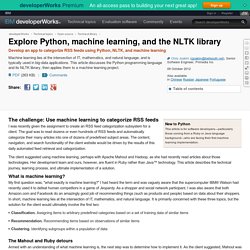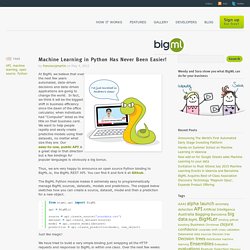

Milk: Machine Learning Toolkit for Python. This is the code that I use for my research projects.

Where can I get it? Github as usual. Alternatively the python packages index also contains official releases,the latest of which can be obtained by: easy_install milk or: pip install milk if you use these tools. Examples Here is how to test how well you can classify some features,labels data, measured by cross-validation: import numpy as np import milk features = np.random.rand(100,10) # 2d array of features: 100 examples of 10 features each labels = np.zeros(100) features[50:] += .5 labels[50:] = 1 confusion_matrix, names = milk.nfoldcrossvalidation(features, labels) print 'Accuracy:', confusion_matrix.trace()/float(confusion_matrix.sum()) If want to use a classifier, you instanciate a learner object and call its train() method: Features Pythonic interface to libSVM. Article filed in categories: Software Work Python. PyML - machine learning in Python — PyML v0.7.3 documentation. Explore Python, machine learning, and the NLTK library.
The challenge: Use machine learning to categorize RSS feeds I was recently given the assignment to create an RSS feed categorization subsystem for a client.

The goal was to read dozens or even hundreds of RSS feeds and automatically categorize their many articles into one of dozens of predefined subject areas. The content, navigation, and search functionality of the client website would be driven by the results of this daily automated feed retrieval and categorization. The client suggested using machine learning, perhaps with Apache Mahout and Hadoop, as she had recently read articles about those technologies. Her development team and ours, however, are fluent in Ruby rather than Java™ technology. What is machine learning? My first question was, "what exactly is machine learning? " Classification. The Mahout and Ruby detours Armed with an understanding of what machine learning is, the next step was to determine how to implement it.
Finding Python and the NLTK print feedparser.parse(" Machine Learning in Python Has Never Been Easier! At BigML we believe that over the next few years automated, data-driven decisions and data-driven applications are going to change the world.

In fact, we think it will be the biggest shift in business efficiency since the dawn of the office calculator, when individuals had “Computer” listed as the title on their business card. We want to help people rapidly and easily create predictive models using their datasets, no matter what size they are. Our easy-to-use, public API is a great step in that direction but a few bindings for popular languages is obviously a big bonus. Thus, we are very happy to announce an open source Python binding to BigML.io, the BigML REST API. You can find it and fork it at Github. The BigML Python module makes it extremely easy to programmatically manage BigML sources, datasets, models and predictions. Just like magic! We have tried to build a very simple binding just wrapping all the HTTP requests and responses to BigML.io within one class.
Mlpy - Machine Learning Python. PyBrain. Machine learning in Python — scikit-learn 0.13.1 documentation. Talk.dvi.